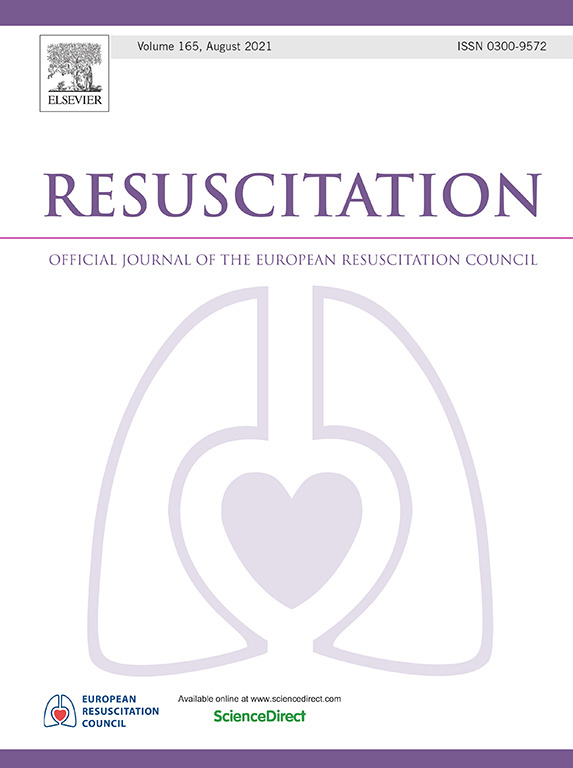Semi-autonomous drone delivering automated external defibrillators for real out-of-hospital cardiac arrest: A Danish feasibility study
IF 6.5
1区 医学
Q1 CRITICAL CARE MEDICINE
引用次数: 0
Abstract
Aim
To assess the feasibility and safety of drone-delivered automated external defibrillators (AEDs) in real out-of-hospital cardiac arrests (OHCAs) in Denmark, addressing the critical need for timely defibrillation in OHCAs.
Methods
In this prospective clinical study in Aalborg, Denmark, an AED-carrying drone was dispatched for suspected OHCAs, from June 2022 to April 2023. The drone was stationed in an urban area (maximum flight-radius 6 km, covering 110,000 inhabitants) within designated airspace not requiring preflight approval from air-traffic control. Upon OHCA-suspicion, the emergency medical dispatcher activated the drone, which autonomously took off and flew beyond-visual-line-of-sight to the OHCA-location. On-site, a remote drone pilot (stationed cross-border) winched down the AED near the patient’s location. Flights were restricted to dry weather, mean windspeeds < 8 m/s, and 8 am to 10 pm.
Results
Of 76 suspected OHCAs, 27 occurred during non-operating hours (nighttime). Of the remaining 49 OHCAs, 16 (33%) were eligible for drone take-off, all of which resulted in successful AED-delivery, without any adverse events. Weather caused 14 cancellations (29%), technical issues (dispatch centre, drone, or hangar problems) 13 (27%), and closed airspace 6 (12%). The median drone response time from activation to AED-delivery was 04:47 min (IQR 03:45–05:27), and the corresponding ambulance response time was 03:25 min (IQR 02:43–04:14). No drone-delivered AEDs were attached.
Conclusion
This study demonstrates the safety and feasibility of drone-delivered AEDs to real OHCAs. Improved time to AED delivery was limited due to swift ambulance service, highlighting the importance of strategic AED drone placement.
目的:评估在丹麦实际发生的院外心脏骤停(OHCAs)中使用无人机投放自动体外除颤器(AED)的可行性和安全性,满足院外心脏骤停患者对及时除颤的迫切需求:在丹麦奥尔堡进行的这项前瞻性临床研究中,从 2022 年 6 月到 2023 年 4 月,丹麦为疑似院外心脏骤停患者派出了一架携带自动体外除颤器(AED)的无人机。无人机驻扎在城市地区(最大飞行半径 6 公里,覆盖 11 万居民)的指定空域内,无需空中交通管制部门的飞行前批准。紧急医疗调度员在收到 OHCA 的怀疑后启动了无人机,无人机自动起飞,在视线范围之外飞往 OHCA 所在地。在现场,一名远程无人机驾驶员(跨境驻扎)将自动体外除颤器吊到病人所在位置附近。飞行仅限于干燥天气,平均风速结果:在 76 例疑似心脏骤停患者中,有 27 例发生在非工作时间(夜间)。在剩余的 49 例心脏骤停患者中,有 16 例(33%)符合无人机起飞条件,全部成功投放了自动体外除颤器,未发生任何不良事件。天气原因导致取消 14 次(29%),技术问题(调度中心、无人机或机库问题)13 次(27%),封闭空域 6 次(12%)。无人机从启动到投放自动体外除颤器的响应时间中位数为 04:47 分钟(IQR 03:45 - 05:27),相应的救护车响应时间为 03:25 分钟(IQR 02:43 - 04:14)。未安装无人机投放的自动体外除颤器:这项研究证明了无人机投放自动体外除颤器对实际 OHCAs 的安全性和可行性。由于救护服务迅速,AED 的投放时间有限,这凸显了战略性 AED 无人机投放的重要性。
本文章由计算机程序翻译,如有差异,请以英文原文为准。
求助全文
约1分钟内获得全文
求助全文
来源期刊

Resuscitation
医学-急救医学
CiteScore
12.00
自引率
18.50%
发文量
556
审稿时长
21 days
期刊介绍:
Resuscitation is a monthly international and interdisciplinary medical journal. The papers published deal with the aetiology, pathophysiology and prevention of cardiac arrest, resuscitation training, clinical resuscitation, and experimental resuscitation research, although papers relating to animal studies will be published only if they are of exceptional interest and related directly to clinical cardiopulmonary resuscitation. Papers relating to trauma are published occasionally but the majority of these concern traumatic cardiac arrest.
 求助内容:
求助内容: 应助结果提醒方式:
应助结果提醒方式:


